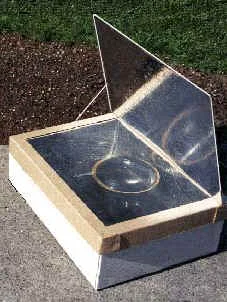Solar Cooker
A Solar Cooker is a device that uses sunlight as an energy source to cook food. The most effective material for a solar cooker is metal painted black to absorb light. It’s top plane is made out of glass to trap heat (Similar to the greenhouse effect). A vessel (painted black) is placed in this heater containing the food. A solar heater has a mirror that helps concentrate sunlight to a particular point/space.A time taken for a solar heater to prepare food varies greatly according to the quantity and type of food, equipment being used, sunlight available and air temperature.
The vast majority of solar cookers presently in use are relatively cheap, low-tech devices. Because they use no fuel and cost nothing to operate, many nonprofit organizations are promoting their use worldwide in order to help reduce fuel costs (for low-income people) and air pollution
Principles
solar cookers use the following basic principles:
- A solar cooker lets the UV light rays in and then converts them to longer infrared light rays that cannot escape.
- Converting light to heat: A black or low reflectivity surface on a food container or the inside of a solar cooker improves the effectiveness of turning light into heat. Light absorption converts the sun’s visible light into heat, substantially improving the effectiveness of the cooker.
- Glass transmits visible light but blocks infrared thermal radiation from escaping. This amplifies the heat trapping effect.
How do the different parts of a solar cooker work
There are three main components to most solar cookers, or you could say three main principles to effective solar cooking; these being:
- Concentration (reflection, or reflectance)
- Absorption (ability to attract or hold heat.
- Retention (means or capacity to retain heat)
Concentration of the sun’s rays is performed most often by reflecting panels, petals and such surfaces that can “focus” or concentrate the rays of light (UV) to a point or concentration.These reflecting panels are usually made of materials that are shiny and reflective due to the substance used in their manufacture, such as silver, chromium and aluminum.
Absorption of the sun’s energy (heat)in solar cooking is best achieved when a surface is dark in color, thus the most common solar oven interiors are usually black in color as well as the color of the cookware used for cooking the food.
Retention is the final principle in solar cooking.If a solar cooker is not well insulated and if it does not have a cover, or lid, then all of the concentrated heat (energy) and all of the absorbed heat would quickly dissipate into the air and be lost to the surrounding environment.A solar cooker must have the means to “trap” or hold the concentrated heat allowing it to accumulate and to “build up” to sufficiently high enough levels to be able to effectively cook.





